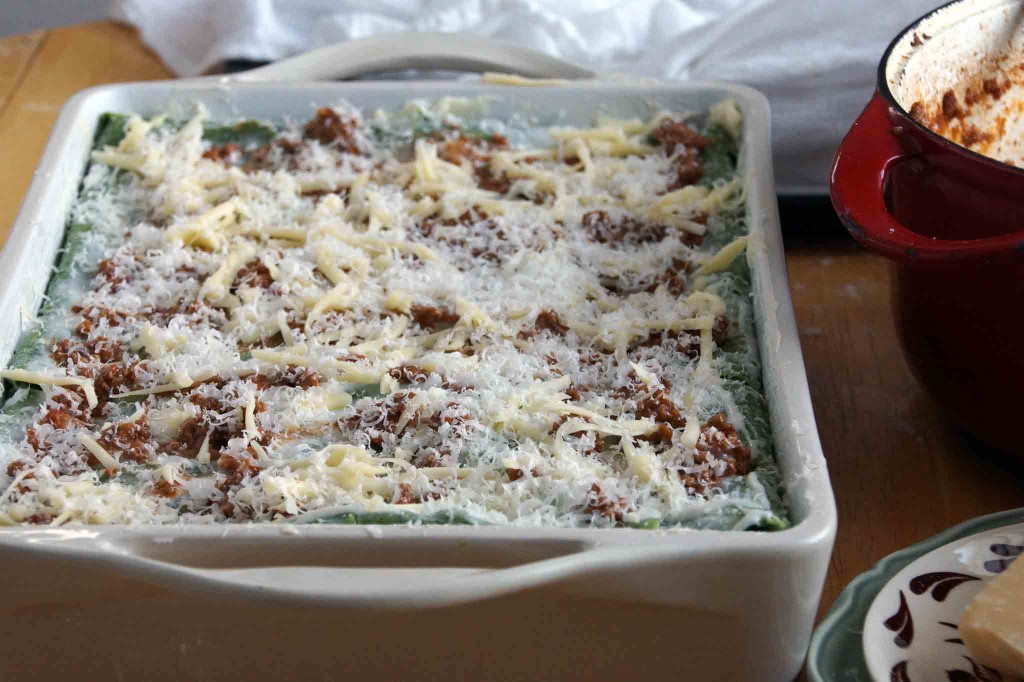 Real-deal homemade lasagna is a wonderful thing. Imagine thin sheets of homemade pasta, layered with silky béchamel and rich meaty Bolognese sauce, stuck together with melted cheese…what could be better?
Real-deal homemade lasagna is a wonderful thing. Imagine thin sheets of homemade pasta, layered with silky béchamel and rich meaty Bolognese sauce, stuck together with melted cheese…what could be better?
Of course, all of that deliciousness comes at a price–lasagna is a serious time commitment! There are 2 sauces to make (one of which cooks for hours and hours), plus pasta to mix, roll, and boil, cheese to grate, and then comes assembling the whole mess. You get the picture–it’s a labor of love. The good news is, everything can be done ahead of time so by the time you eat it, you are relaxed, your kitchen has been cleaned up, and you actually get to enjoy it.
I served this lasagna to my family for our Christmas Eve dinner and (excuse the shameless tooting of my own horn) it turned out to be a great plan! I got it all put together the day before and just popped it in the oven before people started to arrive. My house smelled great and, for once, my kitchen wasn’t a complete bombed-out mess when my family came for dinner. I even managed to comb my hair and slap on a little lipstick. Talk about a Christmas miracle.
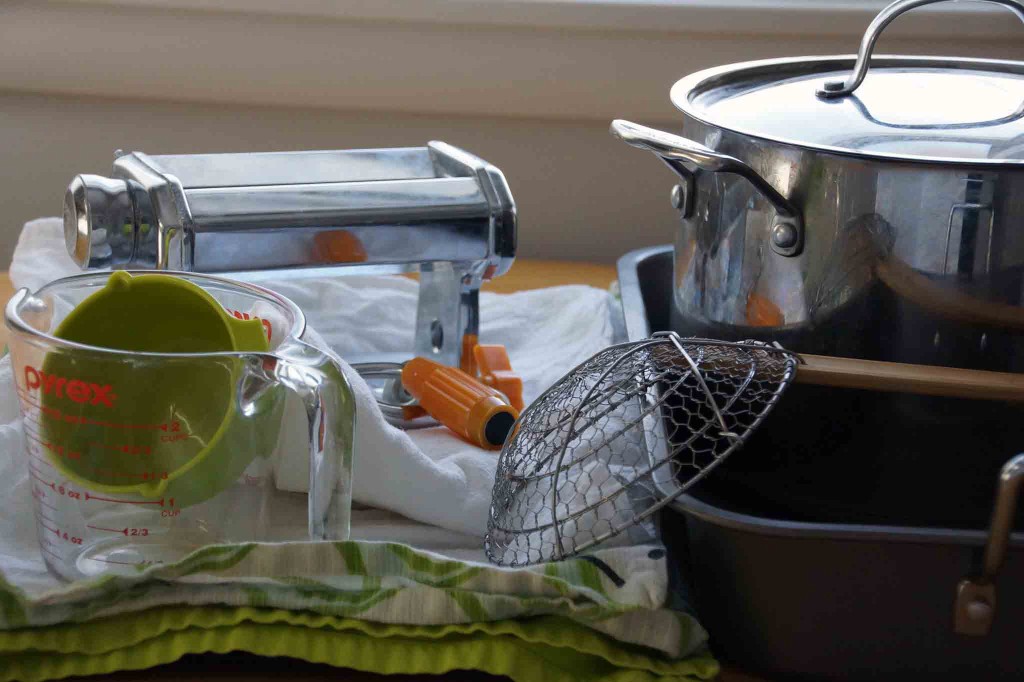 It’s important to stretch the making, baking, and eating of lasagna out over a couple of days otherwise it’s just too overwhelming and you won’t end up appreciating the final product as much as you should. I normally make my Bolognese sauce on day 1, make the béchamel sauce, pasta, and get it all assembled on day 2, and then bake it and have a good time with my dinner guests on day 3. My other words of advice: start with a clean kitchen. You’re about to dirty a lot of dishes and if the place is a mess to begin with, things are going to get ugly–not that I know from experience, of course.
It’s important to stretch the making, baking, and eating of lasagna out over a couple of days otherwise it’s just too overwhelming and you won’t end up appreciating the final product as much as you should. I normally make my Bolognese sauce on day 1, make the béchamel sauce, pasta, and get it all assembled on day 2, and then bake it and have a good time with my dinner guests on day 3. My other words of advice: start with a clean kitchen. You’re about to dirty a lot of dishes and if the place is a mess to begin with, things are going to get ugly–not that I know from experience, of course.
For my lasagna, I follow Lidia Bastianich’s recipe fairly closely. It’s the first I ever made and I adore it, as I adore her gentle way of guiding you through the process.
We’ll start by making the pasta dough. Traditionally, lasagna Bolognese is made with spinach pasta. Making it with plain pasta will save you a little time, but I like the flavor and look of green pasta. And I don’t like doing things halfway.
For the pasta, you’ll need a block of frozen spinach, flour, eggs, and olive oil. Thaw the spinach and wring it out until you think it can’t possibly get any drier.
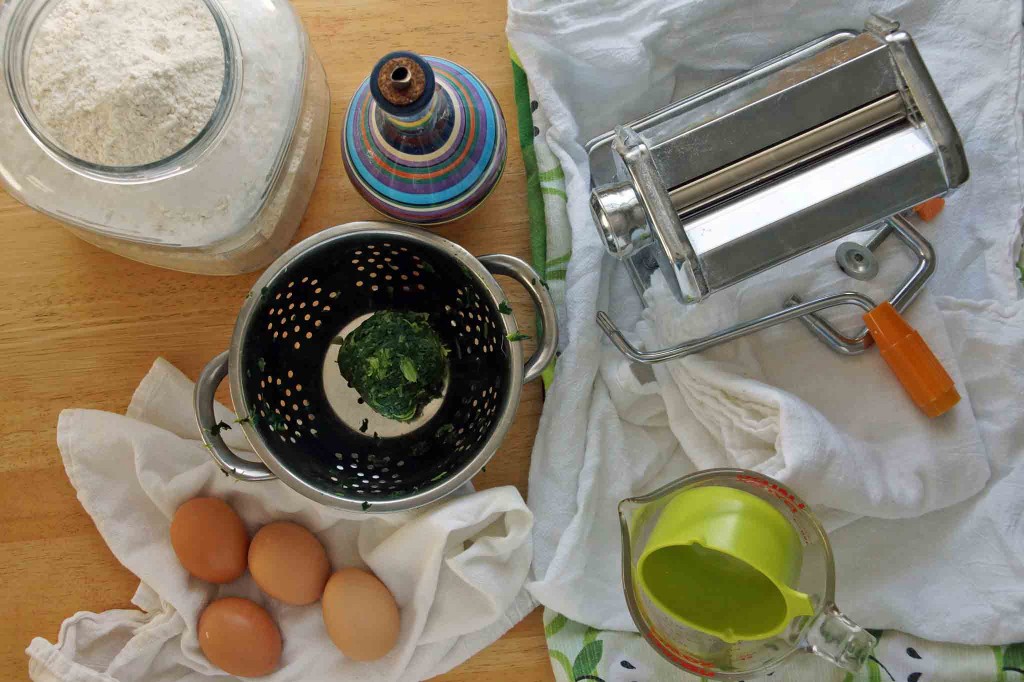 Pop the spinach in the food processor and chop it as finely as you can. Since we’ve already made a mess of the food processor, we may as well make our dough in it, as well. Add flour to the spinach and combine, then, with the motor running, slowly pour in the eggs and olive oil and process until a rough ball of dough starts to form on the blade. Dump it out, knead until smooth. Now wrap it in plastic and let it rest while you make the béchamel sauce.
Pop the spinach in the food processor and chop it as finely as you can. Since we’ve already made a mess of the food processor, we may as well make our dough in it, as well. Add flour to the spinach and combine, then, with the motor running, slowly pour in the eggs and olive oil and process until a rough ball of dough starts to form on the blade. Dump it out, knead until smooth. Now wrap it in plastic and let it rest while you make the béchamel sauce.
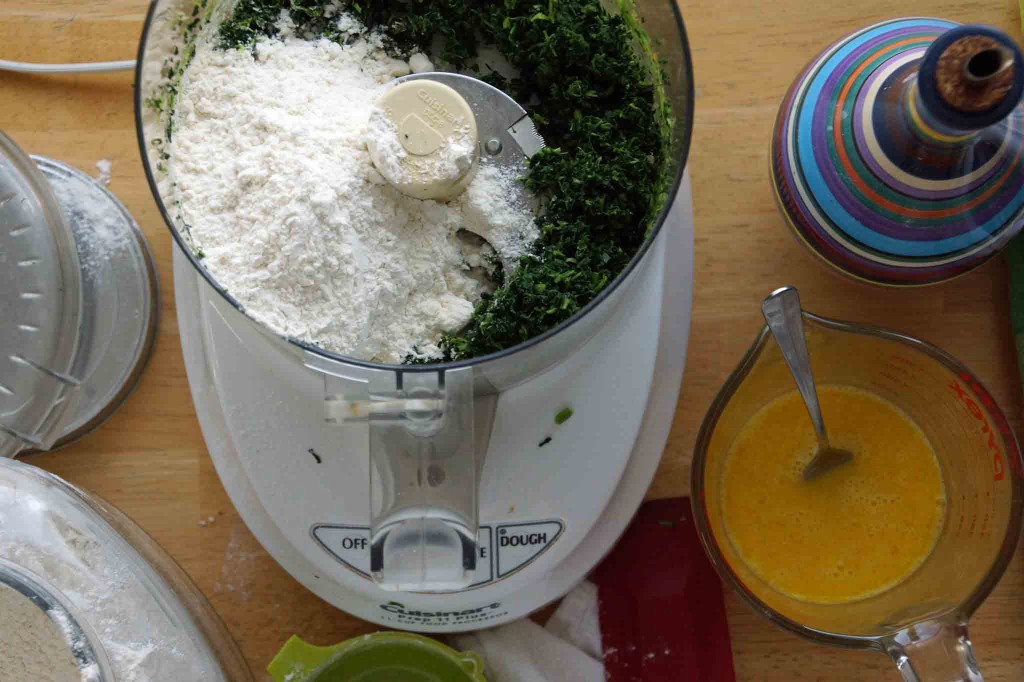
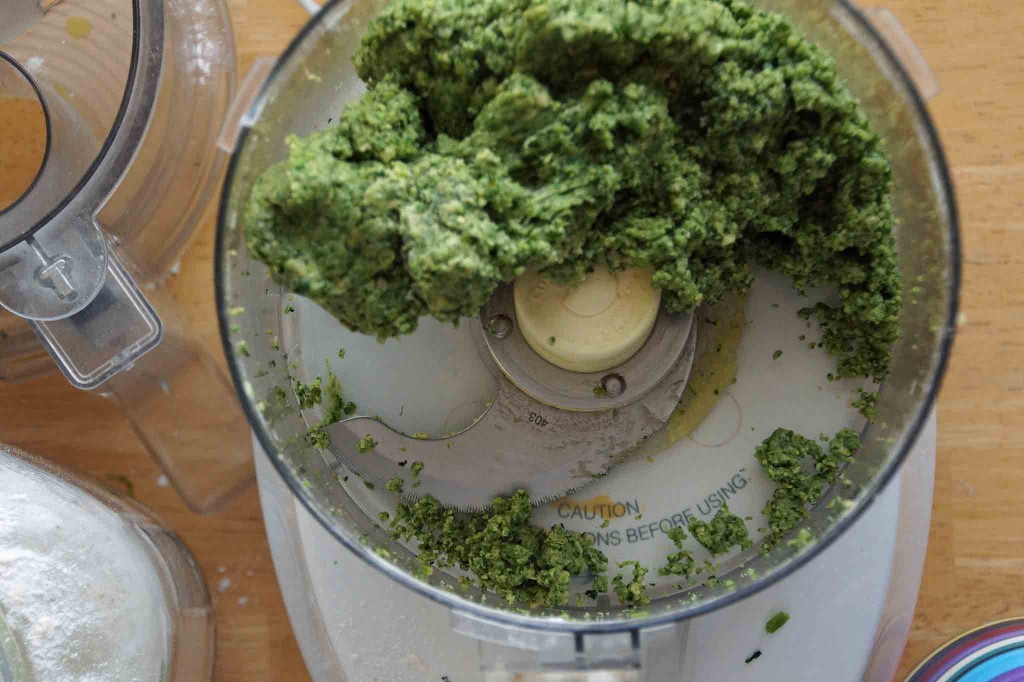
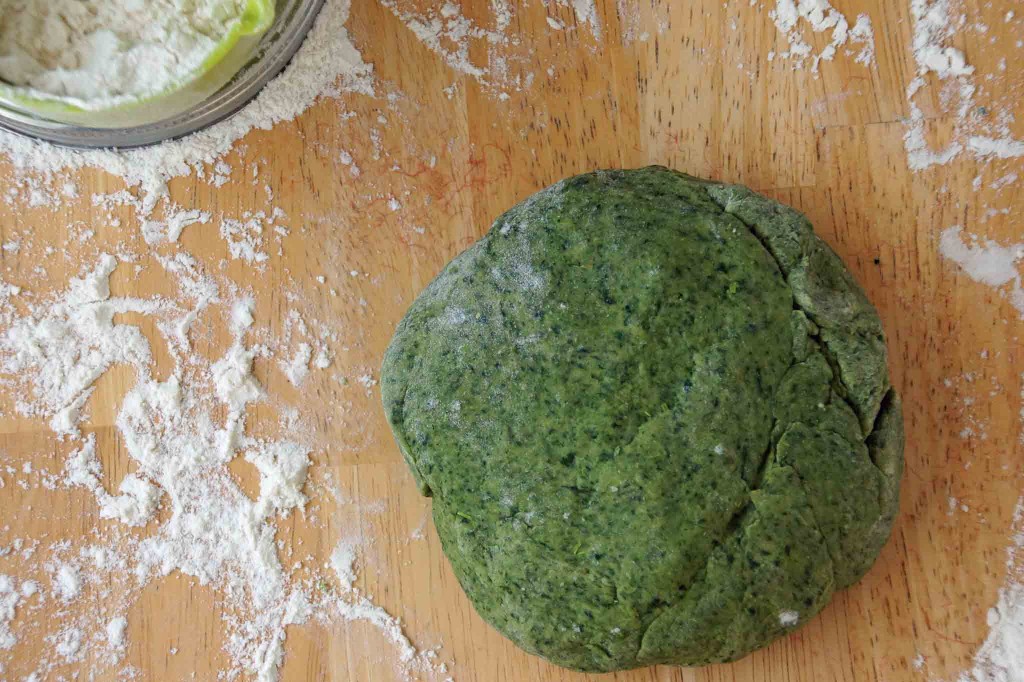 Onward! Let’s make the béchamel sauce. Béchamel will tie everything in our lasagna together and add a seductive creaminess. You’ll need milk, butter, and flour, plus a couple of bay leaves, a few gratings of nutmeg, and a touch of Parmigiano.
Onward! Let’s make the béchamel sauce. Béchamel will tie everything in our lasagna together and add a seductive creaminess. You’ll need milk, butter, and flour, plus a couple of bay leaves, a few gratings of nutmeg, and a touch of Parmigiano.
Heat the milk with the bay leaves and nutmeg in one pan while you make a roux with the flour and butter in another pan. Whisk the hot milk into the roux and cook until the mixture thickens. Strain, stir in the parm, adjust the seasoning, and set it aside while we roll out the pasta. We are making serious progress!
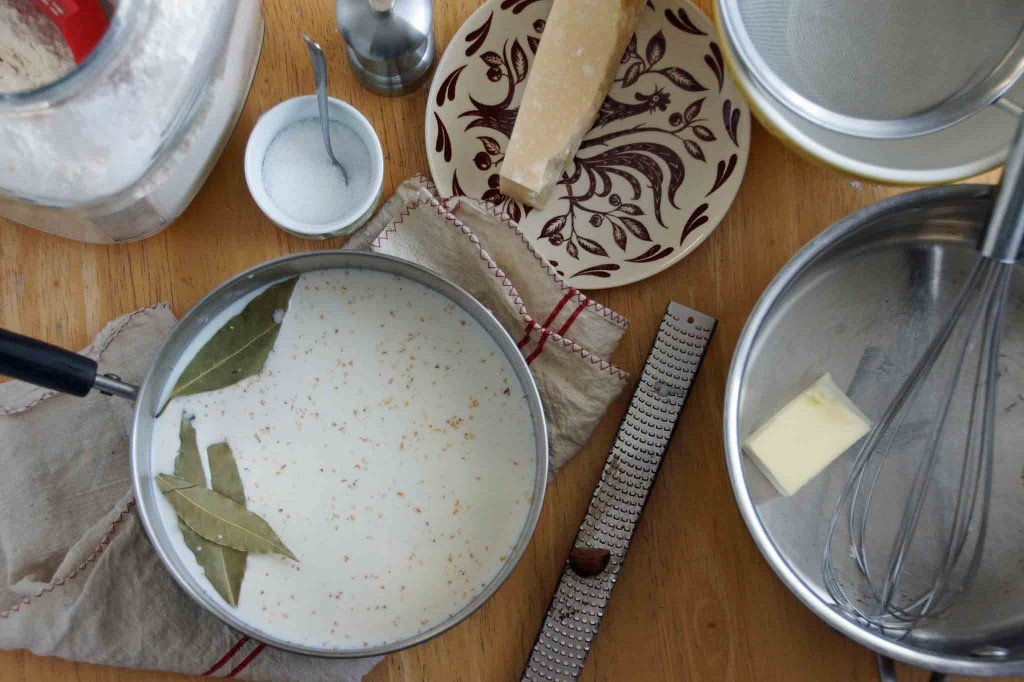
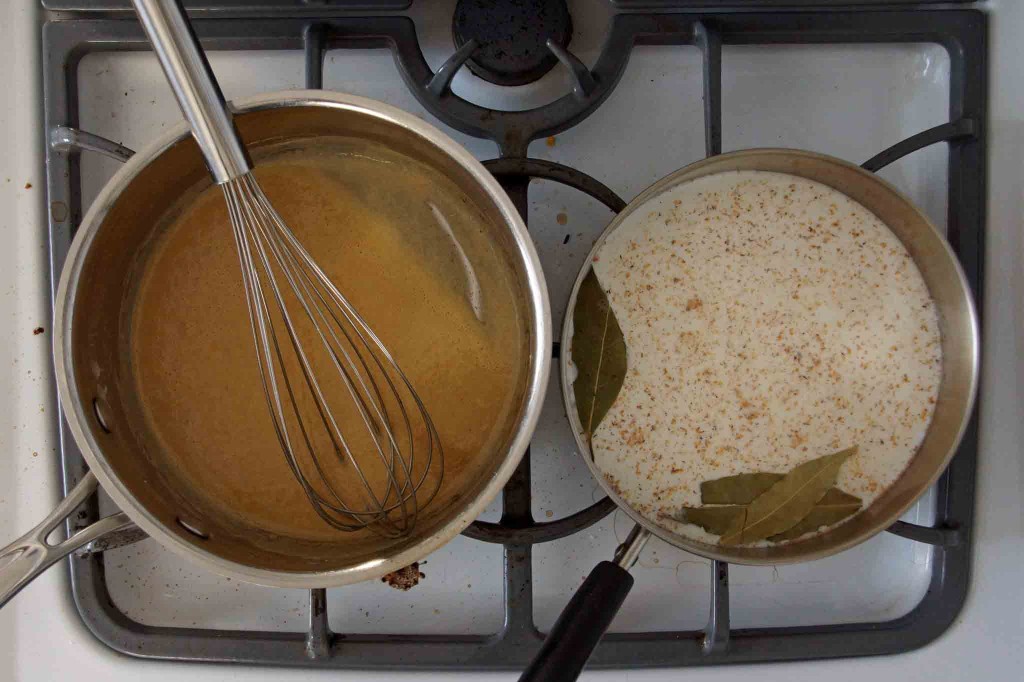
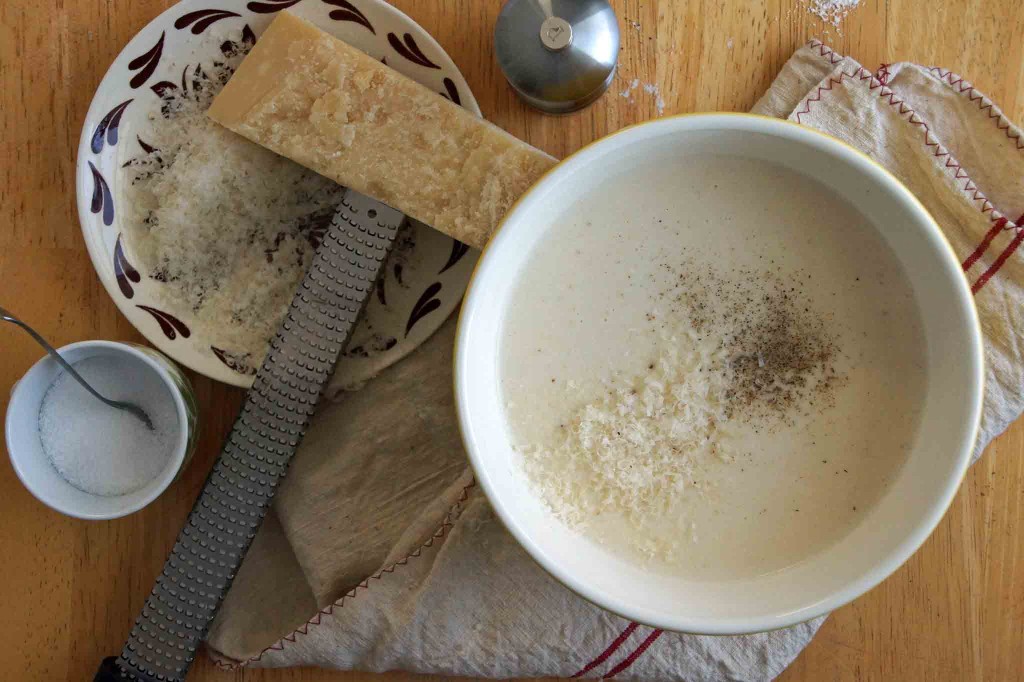 Your pasta dough should be well-rested and easy to work with by now. Divide it into 6 or 8 pieces and get rolling. Start at the thickest setting on your pasta roller and gradually work your way down to the thinnest. As you make the sheets of pasta, lay them on lightly floured towels until you’re ready to boil them.
Your pasta dough should be well-rested and easy to work with by now. Divide it into 6 or 8 pieces and get rolling. Start at the thickest setting on your pasta roller and gradually work your way down to the thinnest. As you make the sheets of pasta, lay them on lightly floured towels until you’re ready to boil them.
When you’ve rolled out all the pasta dough, start cooking the noodles. I set up a work station on my stove top: a big pot of boiling water on 1 side, a roasting pan full of ice water on the other. Boil the noodles, 1 at a time, then shock ’em in the ice water to stop them from over-cooking. Pull them out of the ice bath and lay them out on clean kitchen towels until you’re ready to assemble the beast. We’re getting there, I promise!
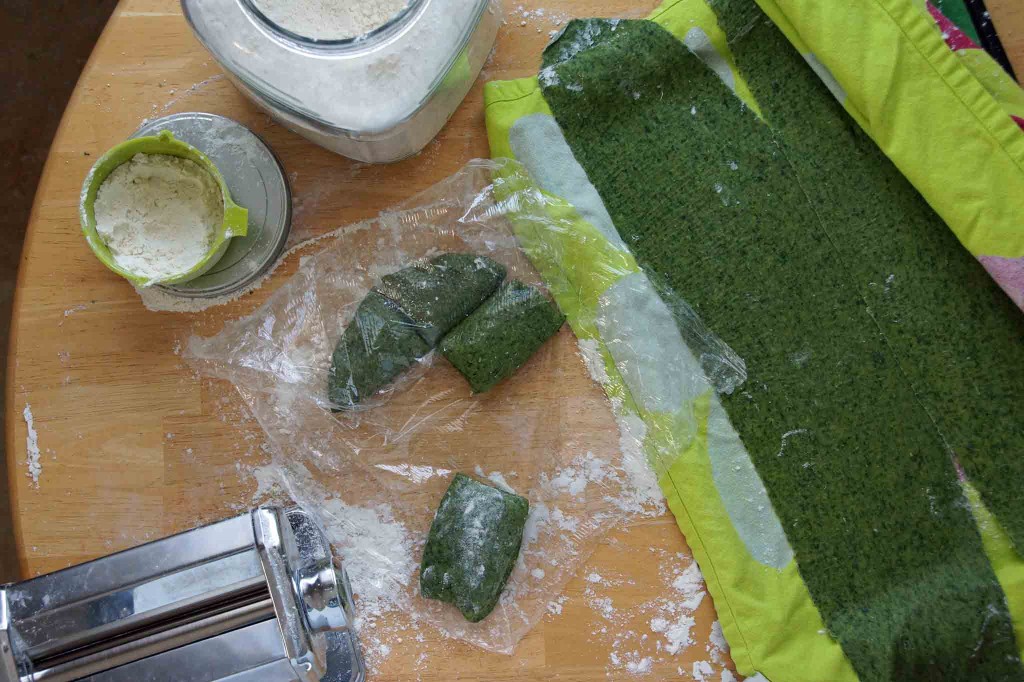
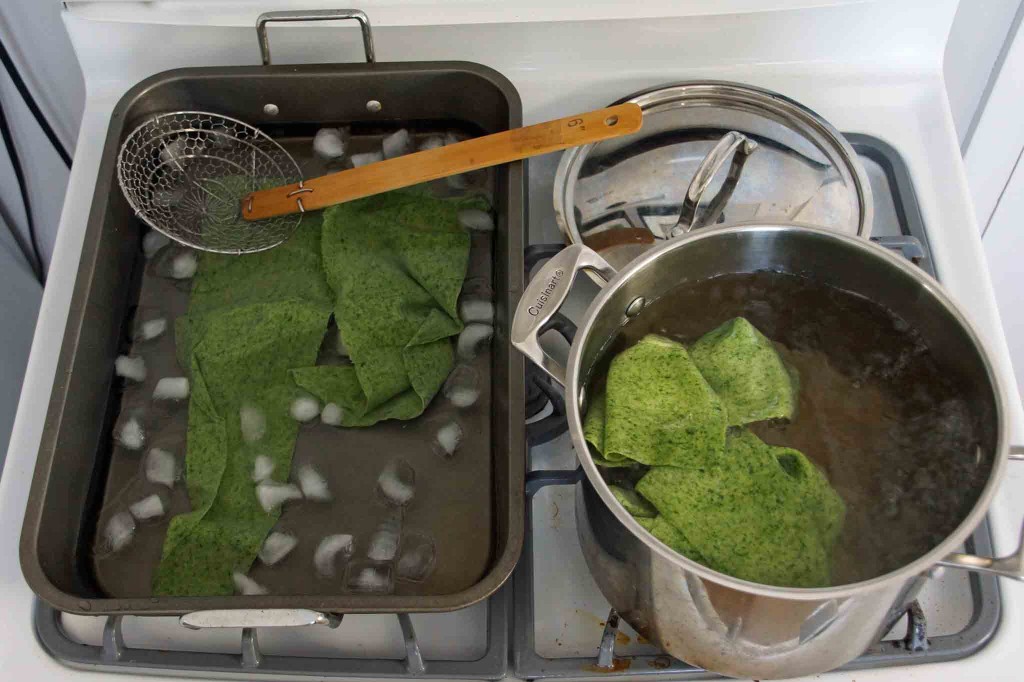 Time to put it all together! Find yourself a clear surface and set out all of the components you’ve labored over: the cooked pasta sheets, Bolognese sauce, and béchamel. Grate a heap of cheese that will melt well (I like Fontina) and a pile of Parmesan. Butter a baking dish and start building your lasagna.
Time to put it all together! Find yourself a clear surface and set out all of the components you’ve labored over: the cooked pasta sheets, Bolognese sauce, and béchamel. Grate a heap of cheese that will melt well (I like Fontina) and a pile of Parmesan. Butter a baking dish and start building your lasagna.
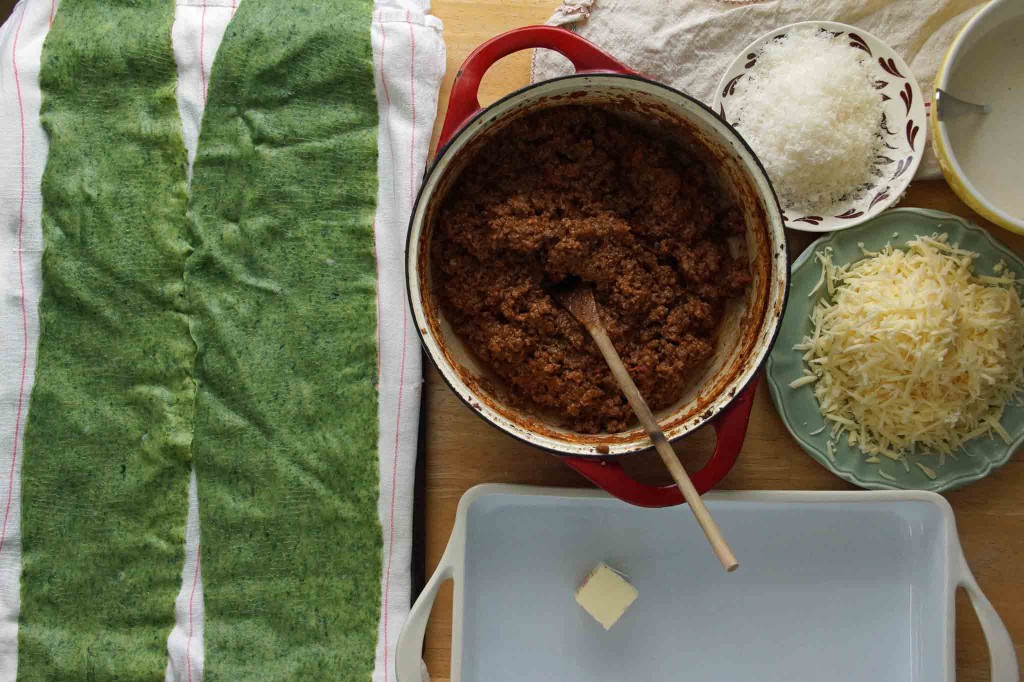 Smear a bit of béchamel on the bottom of the pan and top with a little of the Bolognese. This will anchor the lasagna and keep the bottom layer of pasta from drying out. Now cover the bottom with sheets of pasta, letting a few inches hang over the sides. Smear with thin layer of béchamel, top with a bit of Bolognese, sprinkle with cheese. Repeat. Rather than thinking of the sauces as “filling”, I choose to think of them as the adhesive that holds the noodles together–remember how hard we worked on the pasta? The pasta is every bit as important as the sauces and cheese–we don’t want it getting lost in the shuffle.
Smear a bit of béchamel on the bottom of the pan and top with a little of the Bolognese. This will anchor the lasagna and keep the bottom layer of pasta from drying out. Now cover the bottom with sheets of pasta, letting a few inches hang over the sides. Smear with thin layer of béchamel, top with a bit of Bolognese, sprinkle with cheese. Repeat. Rather than thinking of the sauces as “filling”, I choose to think of them as the adhesive that holds the noodles together–remember how hard we worked on the pasta? The pasta is every bit as important as the sauces and cheese–we don’t want it getting lost in the shuffle.
When you are creating the top layer, fold the overhang up over the top of the lasagna and smear with the last of the bechamel and a bit more Bolognese. Sprinkle with a final dusting of cheese and your hard work is over. All that’s left is baking it off. And the dishes. Ugg.
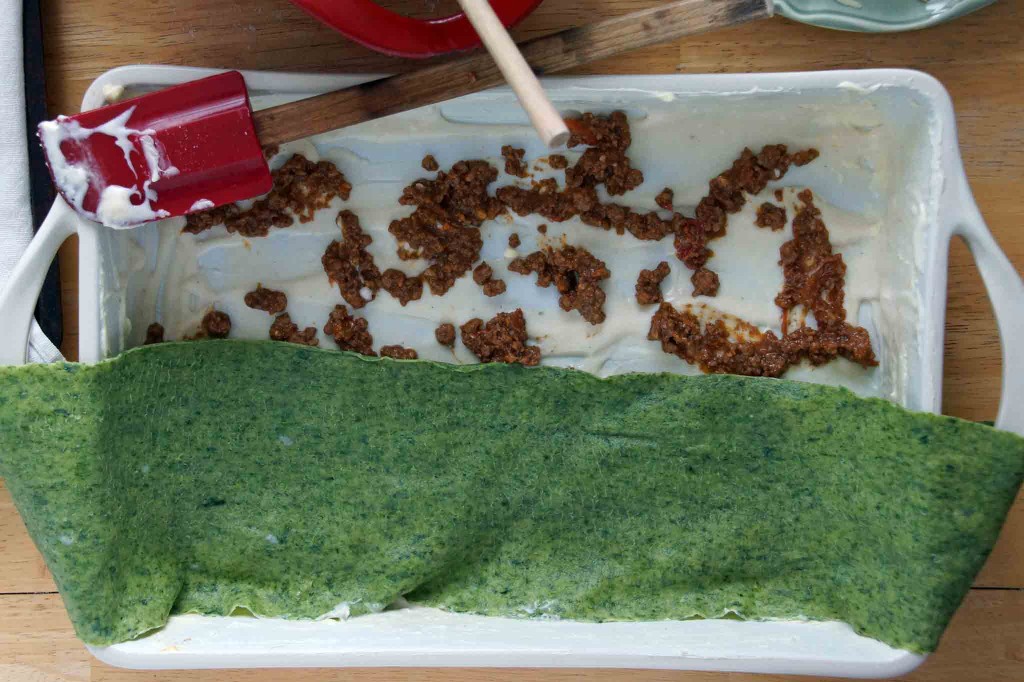
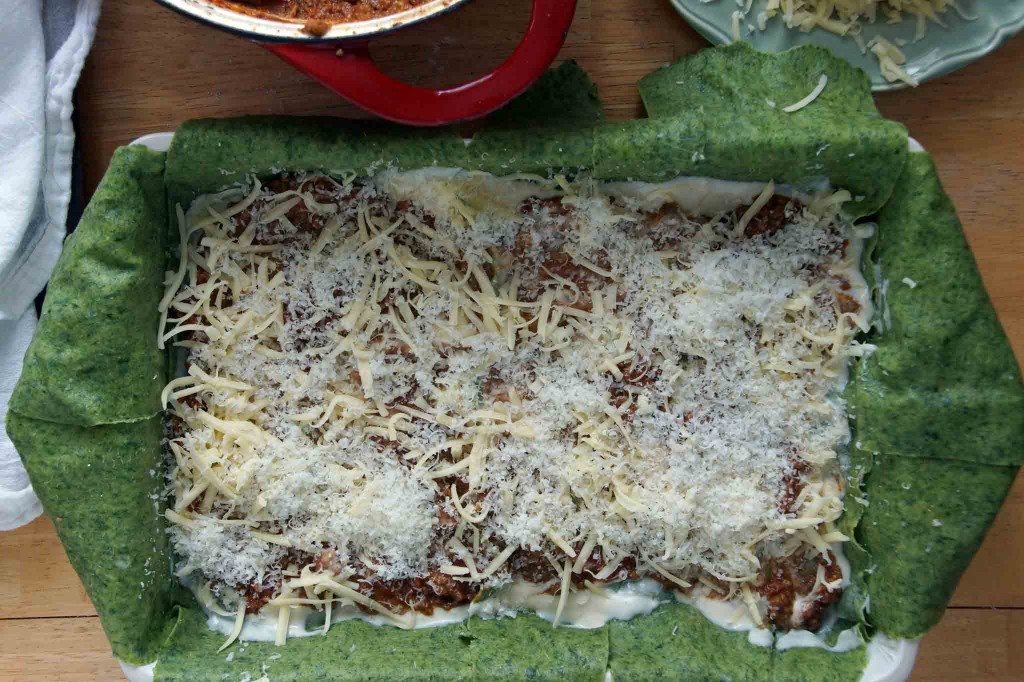
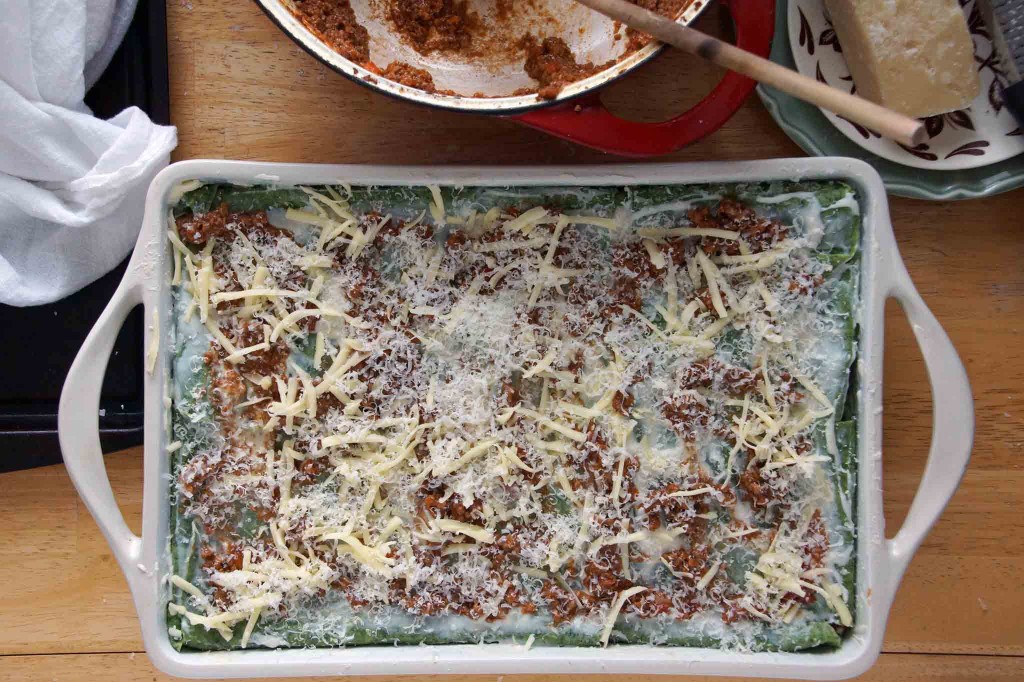 Now comes the easy part–baking and eating! Hopefully by now you’re caught up on the dishes, well-rested, and hungry. Bake the lasagna first under a foil tent, then remove it and let the top get a little color. When it’s done baking, let it rest for a good 15 minutes before you start to dish it up or the pieces will fall apart. I know, I know, the waiting will nearly kill you, but you’ve committed some serious time to this pan of lasagna, you want it to look as good as it’s going to taste.
Now comes the easy part–baking and eating! Hopefully by now you’re caught up on the dishes, well-rested, and hungry. Bake the lasagna first under a foil tent, then remove it and let the top get a little color. When it’s done baking, let it rest for a good 15 minutes before you start to dish it up or the pieces will fall apart. I know, I know, the waiting will nearly kill you, but you’ve committed some serious time to this pan of lasagna, you want it to look as good as it’s going to taste.
When I was a very young kid, my mother would make lasagna every Christmas Eve. I’m hoping the lasagna I served this year will encourage my family to reinstate the tradition! Buon Appetito!
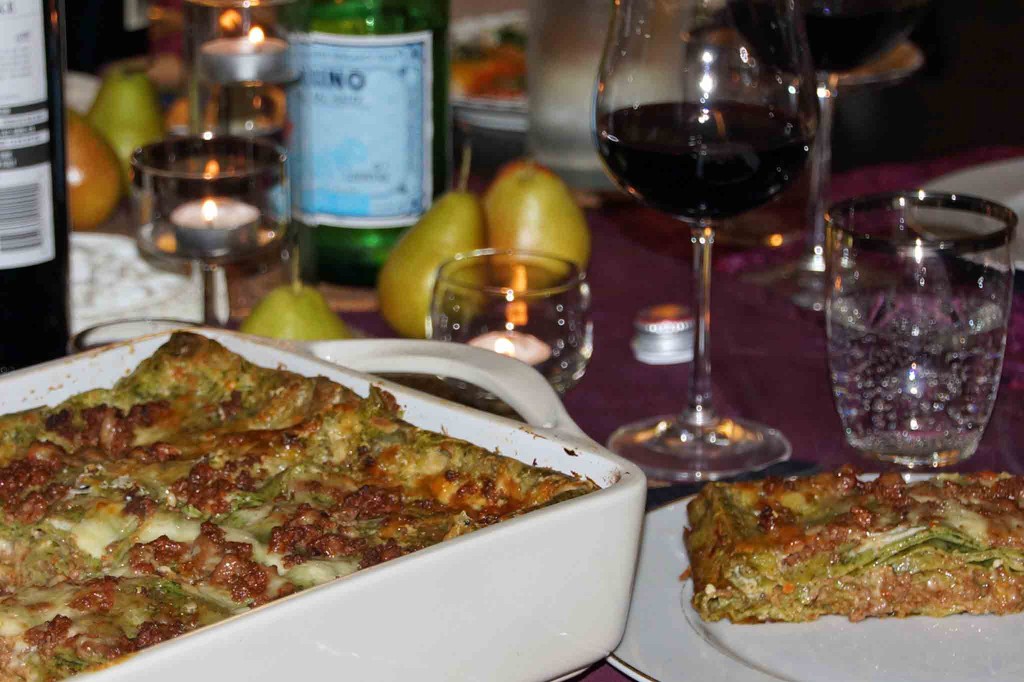
- For the Pasta:
- 1 10 oz. package Frozen Spinach, defrosted
- 2 c. All-Purpose Flour, plus additional for kneading and rolling the dough
- 2 Whole Eggs
- 2 Egg Yolks
- 1 Tbsp. Extra Virgin Olive Oil
- For the Béchamel Sauce:
- 4 c. Whole Milk
- a few gratings of Nutmeg
- 2 Bay Leaves
- 3 Tbsp. Butter
- 4 Tbsp. All-Purpose Flour
- ¼ c. Grated Parmesan
- And Finally:
- ½ batch (about 4 c.) ">Bolognese Sauce
- 3 c. grated Fontina Cheese (or any good Italian melting cheese)
- 2 c. grated Parmesan Cheese
- 1-2 Tbsp. softened Butter, for greasing the pan
- First, we’ll make the pasta dough. Squeeze the thawed spinach to remove as much liquid as possible. When you are convinced it can’t get any drier, place the spinach in the bowl of a food processor. Pulse until the spinach is finely chopped. Add 2 c. flour and pulse to combine. Whisk together the eggs, egg yolks, and olive oil in a liquid measuring cup. With the food processor running, slowly pour the egg mixture into the flour and process for 30 seconds. Scrap down the sides and the bottom of the bowl and continue to process until a rough ball of dough forms on the blade. Transfer the ball of dough to a floured board or countertop and knead briefly until it feels smooth and elastic. Wrap tightly in plastic wrap and allow to rest at room temperature for at least 30 minutes before rolling.
- While the pasta dough rests, make the béchamel sauce. Combine the milk, nutmeg, and bay leaves in a medium saucepan and heat to almost a boil. While the milk heats, melt 3 Tbsp. butter in a second saucepan over medium heat. When the butter starts to bubble and foam, whisk in 4 Tbsp. flour. Continue to whisk until the mixture is very smooth and lightly golden. Now slowly pour the hot milk into the butter and flour mixture while stirring. Bring to a boil, then reduce the heat slightly and continue to cook at a steady perk until the sauce thickens, about 5 minutes. Pour the sauce, through a mesh sieve, into a medium bowl and stir in the ¼ c. of Parmesan. Taste; season with salt and freshly ground black pepper. Press a small sheet of plastic wrap to the surface of the sauce to keep a film from forming. Set aside until you are ready to assemble the lasagna. You could certainly make this a day or 2 ahead and refrigerate until you’re ready to use it.
- Get a large pot of water on the stove to boil while you roll out the pasta. Divide the dough into 6 even pieces. Working with 1 piece at a time, flatten it slightly with your palms, then lightly flour it and roll it through a pasta roller, starting at the thickest setting and gradually working your way down to the thinnest. If the pasta gets too long to comfortably manage, feel free to cut them in half. Don’t worry if the sheets of pasta aren’t perfectly rectangular—once you build the lasagna no one will be able to tell. As you finish each sheet of pasta, lay them flat on a flour-dusted clean kitchen towel on top of a baking sheet.
- Now prepare to cook the pasta. Salt the boiling water and prepare a large ice bath to shock the pasta after it has cooked. I use a large roasting pan set over 2 burners of my stove so it is nearby and transferring the pasta is easy. You’ll also need another baking sheet and more clean kitchen towels (sorry, the laundry is piling up almost as fast as the dishes!) for the cooked pasta. Cook the pasta, 1 or 2 pieces at a time, by slowly lowering each piece into the boiling water. As you lower it in, the water will take over and grab it from you. Cook the pasta until it floats up to the top and appears evenly cooked, about 1 minute. Gently remove, letting the hot water drain off, and place in the ice bath to stop it from cooking any farther. As soon as the pasta has cooled, pull it out of the ice water, let the water drain off, and transfer to a clean towel. Repeat until all of the pasta has been cooked. You’ll find a rhythm in the process and it will not take very long at all (promise!).
- If you are planning to bake the lasagna as soon as it’s assembled, now would be a good time to preheat your oven to 375°.
- Time to assemble the lasagna! If you’re organized about it, the process goes more a lot more smoothly. If you made your Bolognese sauce a day or more ahead of time, warm it just to the point of being spreadable, otherwise it may tear the pasta. Have your 2 sauces (each with its own spatula), the grated cheeses, and pasta all within an arm’s reach of a deep 9 in. x 13 in. baking dish. Grease the bottom and sides of the baking dish with the softened butter. Coat the bottom and sides of the dish with a thin coating of the béchamel. Now spread about ½ c. of Bolognese sauce over the bottom of the pan. Place pasta sheets side-by-side to cover the bottom of the pan and extend over the edges of the pan a few inches (see pictures above). Cover the pasta with a thin layer of béchamel, and then top with another thin coating of Bolognese sauce. Now place pasta sheets perpendicular to the first layer of pasta, extending a few inches over the other sides of the pan. Okay, now we have a good, sturdy base established and we can start building slightly thicker, cheesy layers. Top the pasta with béchamel, Bolognese, and a sprinkling of Parmesan and Fontina cheeses. Arrange pasta sheets to cover the sauces and cheese and repeat. The amount of each ingredient you spread between the layers will depend a little on how many sheets of pasta you wound up with—use your best judgment. I think I ended up with about 6 layers of pasta in my lasagna, with about ½ c. of each sauce between each layer. When you get to the top, fold the overhanging edges up over the lasagna and fit a piece of pasta to cover the center. Spread the last bit of each sauce over the top and sprinkle with the remaining cheese.
- Now you can bake the lasagna or wrap it, put it in the fridge, and bake it tomorrow. When you are ready to bake the lasagna, have the oven preheated to 375°. Tent the lasagna loosely with foil (be sure the foil isn’t touching the cheese or it you’ll pull the cheese off when you remove it). Poke a few holes in the foil to allow steam to escape. Bake for 45 minutes or until the lasagna is bubbling hot. If your baking dish isn’t very deep, you may want to bake the lasagna on a baking sheet to catch any potential bubbling over. Remove the foil tent and return the lasagna to the oven until the cheese on top is golden and crispy. Let the lasagna rest for at least 15 minutes before serving.
- Make someone else do the dishes. Those are direct orders.
Still hungry or did I lose you somewhere around the béchamel? Here are a few other explorations in lasagna and baked pasta (all with squash, I just realized):
Wild Mushroom & Squash Crêpe Lasagna
Wow! This is the real-deal homemade lasagna! That spinach pasta looks amazing!